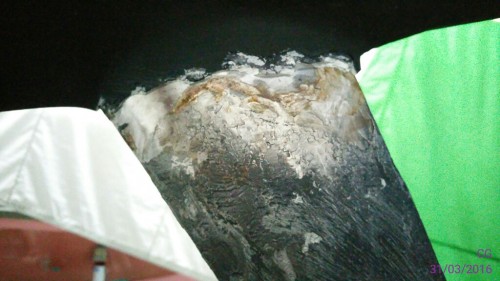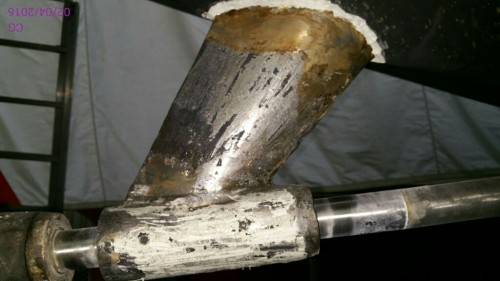Do you want to be informed on new Posts on this Thread? (members only)
| S&S Swan Maintenance - Swan431 - shaft strut - corrosion |
|---|
|
Join Date: 17 March 2010
Posts: 48 |
||
|---|---|---|
|
Swan431 - shaft strut - corrosion |
|
Join Date: 17 March 2010
Posts: 48 |
||
|---|---|---|
|
Dear Forum,
may I ask another question, after my recent posts. This winter season is battery management and underwater issues time. My shaft strut has shown a bit of corrosion, over a few years. Last summer this got worse, and I am now looking at fixing the problem. See attached some photos. I found that the strut was covered with quite a thick layer of filler. It seems that over time this filler came loose, and underneath I seem to have crevice corrosion. But it seems to me that there also is (or was) some corrosion created by an electrical problem, possibly from former times, as there are a few significant traces of deep corrosion, which were covered by the filler. The boat has a retrofitted propeller shaft (metric now), a retrofitted strut bearing, all done in 2000 when I replaced the engine, and a 3-bladed Max-Prop. Shaft and propeller have no corrosion whatsoever. I have three anodes, one on the Max-Prop tip, and two on the shaft, either side of the strut. My feeling would be I should reduce the filler thickness, just put what is required to fill the holes, not more, and fair the hull connection area, and I should probably check the electric system. Any thoughts or experiences on your side? What is the best way to get the filler not come loose again? Any recommendations how to activate or prime the ss surface? Thanks!
Christian Chinook // 431-003   |
|
Join Date: 17 March 2010
Posts: 48 |
||
|---|---|---|
   |
|
Join Date: 17 March 2010
Posts: 48 |
||
|---|---|---|
 Significant corrosion here, after removing the filler |
|
Join Date: 02 January 2008
Posts: 1547 |
||
|---|---|---|
|
Dear Christian If a cable is connected to the shaft strut on the inside it should be disconnected. It is likely that there is an electrical leak causing the corrosion.
Pls see this thread for getting filler to stick
http://www.classicswan.org/forum/post_thread.php?thread=510
Kind regards
Lars
|
|
Join Date: 17 March 2010
Posts: 48 |
||
|---|---|---|
|
Dear Lars,
thanks for your recommendation. Interesting thread. Had not found that myself. The forum is so diverse, now! I will look for a cable at the strut today, will also remove the battery box and take photos of the keel aft end hull stiffeners.
Christian CHINOOK // 431-003 |
|
Join Date: 17 March 2010
Posts: 48 |
||
|---|---|---|
|
Dear Lars,
I further investigated the situation. Yes, there is some corrosion caused by electrolysis. Seems to be old though. I shall do an electric leakage test, but it seems to me that I should do that when the boat is in the water. No electrolyte, on the hard. Correct? Or not? Some of the rust colour stuff on the upper strut is no rust as I found out. It is flexible and can be bent, must be some old primer or activator left on the ss surface. Don't know what exactly this is, but definitely no rust. My father had a galvanic shop long ago, I know what rust looks alike :-) And, Lars, there are 4 cables screwed to the strut. 2 of these look like the original light protection cables from Nautor, one is yellow and green and I think it is some grounding wire from the electric system behind the switch panel, and no. 4 is thinner, black, looks more like a later addition, don't know yet where this goes to. Shall I take them off the strut but leave them connected to each other, or what would you recommend to do?
Christian CHINOOK // 431-003    |
|
Join Date: 17 March 2010
Posts: 48 |
||
|---|---|---|
 |
|
Join Date: 17 March 2010
Posts: 48 |
||
|---|---|---|
 |
|
Join Date: 02 January 2008
Posts: 1547 |
||
|---|---|---|
|
Dear Christian Checking for electrical leaks can be done also ashore for external parts, but then you need to find the path for the electricity by trying to connect to suspect points. If the cables are removed from the strut testing it has no purpose.
If you use shore power ashore it should be noted that there is no earth connection normally provided by the water, and an earth cable is required from a metal rod or tube in the ground or water.
The thick cables are part of the lightning protection system, and the ends should be connected after removal. For the other cables the purpose needs to be found out, and an alternative grounding point like a keel bolt used if required.
Kind regards
Lars
|
|
Join Date: 17 March 2010
Posts: 48 |
||
|---|---|---|
|
Dear Lars,
thanks again for your recommendations. I have now sanded the shaft strut, and it looks quite OK. Will follow the recommendations given for re-coating. And I will disconnect the lightning protection from the strut.
Best Regards Christian Chinook // 431-003 |
- Threads : 1715
- Posts : 10273
- Members: 823
- Online Members: 0

